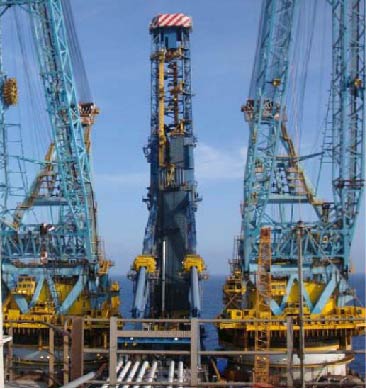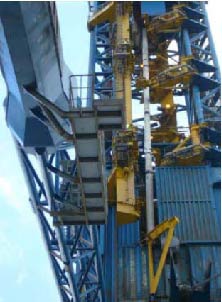Failure of pipe handling system causes injuries and fatalities
A member has reported an incident in which the failure of a J-lay pipe-handling system caused two pipes to be dropped, one of which caused injuries to eight people, four of whom died as a result. During pipe-laying operations, a system failure in the hydraulic pipe handling system of the J-lay tower (JLT) caused two quadruple joints being handled at the same time in two different areas of the tower to drop suddenly. Each piece of pipe was 50m long with a diameter of 24″ and weighed approximately 20 tons.
Just prior to the incident the pipe-laying operation was stopped. Operators reported a system failure and that the hydraulic power had been lost. Such an occurrence was not particularly unusual and, in line with company procedures, this was investigated immediately. A team of technicians led by the chief electrician tried without success to resolve the problems. After these attempts, a more in-depth analysis was made. It was decided, on the basis of input from the system diagnostics, to perform a memory reset. Following this the system appeared to be running correctly. This was the first time that a full memory reset was requested by the internal diagnostics of the control system during a project operational phase.
Only after all indications that everything was in order and all systems were up and running again was the instruction given to the operator to restart the hydraulic packs. As soon as the hydraulic power packs were started, a loud bang was heard along with the noise of the hydraulic systems. One quadruple joint within the J-lay tower, held by the transfer system, was released and fell about a metre to the upper welding deck. At the same time, the quadruple joint held by the pipe elevator at the top of the J-lay tower was also released from its clamps and the hydraulic safety stop swung away, allowing the pipe to fall the full height of the tower, smashing through the access platform located outside the non-destructive testing/coating station to the lower deck below.
All the people who were injured had been on the access platform which was destroyed. The force of impact caused some of the injured persons to fall down on to the lower deck at the base of the pipe-lay tower and some to be thrown overboard.
Eight persons were injured, two seriously and two slightly. Four of the injured persons died as a result of their injuries.


The primary causes of the incident were found to be:
- Sudden release of the two quadruple joints was caused by a failure in conceptual design of the control system software. The program relevant to the JLT initialising instruction was pre-loaded in the erasable programmable read-only memory (EPROM) of the programmable logic controller (PLC) with the instruction to open all clamps. Members are recommended to investigate the possibility that this could happen to the PLC-based control systems on equipment on their vessels.
- The unnecessary presence and uncontrolled access of working personnel on to the access platform destroyed by the falling pipe exposed personnel to suspended load/dropped object hazard.


Following investigation of the incident, a number of corrective actions were put in place by the company:
- The first primary cause was resolved with the removal of the EPROM memories from the system;
- The second primary cause has been addressed by a revision of the vessel and JLT working methodologies; pipe handling activities have been reconsidered through a dropped object philosophy in order to identify mechanical and electrical barriers, additional controls, and new set of operational procedures;
- Electrical controls:
- a number of clamp opening operations were prevented by adding electrical circuit breakers
- all critical sequences will be called by PLC and must be confirmed by operator via electrical push buttons;
- Mechanical controls:
- different systems have been and will be implemented to prevent the vertical pipe drop in any section of the JLT, to restrain lateral pipe movement and fall and to secure the pipe until the internal line up is completed in the upper welding station
- an additional public address system was installed for use during quadruple joint loader lift, and audible and visible alarms for elevator movements
- a safety net was installed underneath the J-Lay tower platforms to guarantee protection against persons falling overboard;
- Procedures were revised in light of the incident, with the following points highlighted:
- all pipe handling activities are to be considered as working under suspended loads
- the immediate area around the JLT is restricted to essential personnel only
- transit and from the JLT to be controlled by dedicated watchmen
- no personnel at all allowed in certain areas during J-lay operations.
Safety Event
Published: 19 December 2008
Download: IMCA SF 18/08
IMCA Safety Flashes
Submit a Report
IMCA Safety Flashes summarise key safety matters and incidents, allowing lessons to be more easily learnt for the benefit of all. The effectiveness of the IMCA Safety Flash system depends on Members sharing information and so avoiding repeat incidents. Please consider adding [email protected] to your internal distribution list for safety alerts or manually submitting information on incidents you consider may be relevant. All information is anonymised or sanitised, as appropriate.
IMCA’s store terms and conditions (https://www.imca-int.com/legal-notices/terms/) apply to all downloads from IMCA’s website, including this document.
IMCA makes every effort to ensure the accuracy and reliability of the data contained in the documents it publishes, but IMCA shall not be liable for any guidance and/or recommendation and/or statement herein contained. The information contained in this document does not fulfil or replace any individual’s or Member's legal, regulatory or other duties or obligations in respect of their operations. Individuals and Members remain solely responsible for the safe, lawful and proper conduct of their operations.
